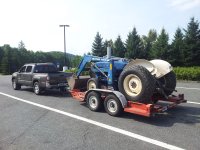What I do is weigh the truck first. At my local scale(truck stop) it has 3 pads. I put the front axle on one and the rear axle on another. Next go back with your trailer loaded as you think it needs to be. Pull on the scales again with the front axle on one pad, the rear axle on another, and finally the trailer on the last one.
What this will tell you is:
A: How much your truck weighs first time you weigh it.
B: How much your truck and trailer weigh together when you go the second time.
C: How much weight your truck gains via tongue weight during the second weighing.
Ideally you want 10 to 15% of the trailer total weight as tongue weight.
So as a example lets say you have a 1/2 ton 4x4 and you weigh it with 3/4 tank of fuel and you in it. Lets say it weighs 5,800# total with 3,000# on the front axle and 2,800# on the rear.
Now you go back again with the same fuel and driver and its now a total weight of 10,800#. We already know the truck is 5,800# so the trailer is 5,000# for argument sake. Now look at your pad weights. Lets say the front axle is now at 2,900# due to the unloading from the trailer, the rear axle is now at 3,500# due to the tongue weight. This now makes your truck 6,400# so you have 600# of tongue weight or 12% of the trailers total weight. Now look at the trailers pad and the weight should be the trailers weight minus the tongue weight, or 4,400#. 5000#-600# of tongue weight.
Once you get it all where you want it mark your trailer where you need your tractor to go. With my rig I back my tractor on if not hauling a 3 point implement and pull it on forward if I have something on the 3 point.
Chris


